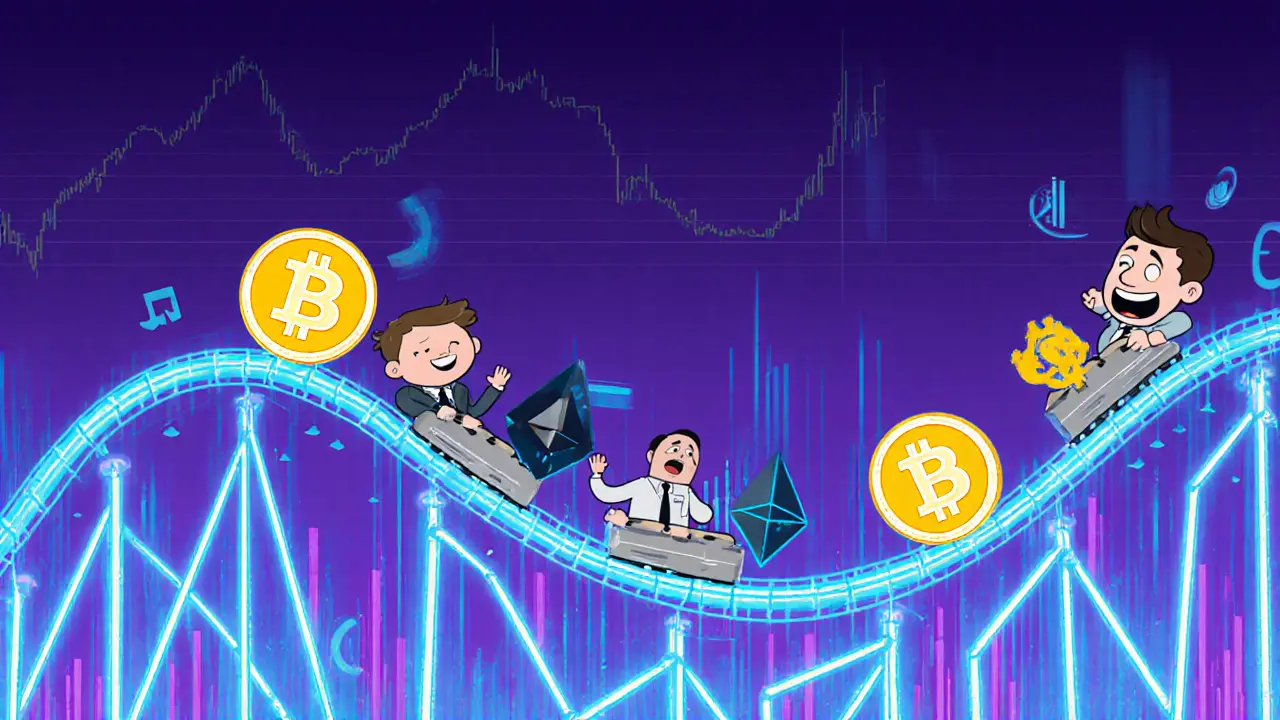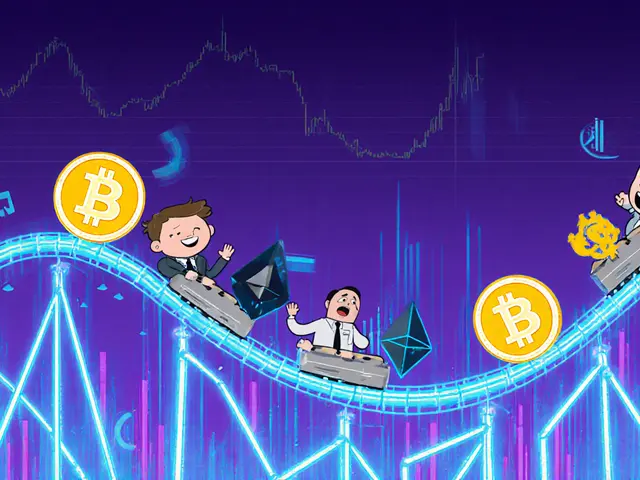Cryptocurrency Volatility vs Trading Opportunities: A Practical Guide

Cryptocurrency Volatility Calculator
Enter Your Trading Parameters
When it comes to digital assets, cryptocurrency volatility is the rate at which crypto prices swing up or down over a given period. Those rapid swings are what make crypto markets feel like a roller‑coaster, but they also hide a map of profit chances for traders who know how to read them.
Key Takeaways
- High volatility means bigger price moves, which can boost gains if you time entries and exits right.
- Supply caps, whale activity, and market sentiment are the three biggest volatility drivers.
- Tools such as Average True Range, implied volatility surfaces, and the VIX Index help you quantify risk.
- Options strategies (straddles, strangles) let you profit from volatility itself, not just direction.
- Robust risk management-position sizing, stop‑losses, and diversification-keeps the downside in check.
Understanding Volatility in Crypto
Volatility measures how much an asset’s price deviates from its average over a set timeframe. In crypto, the deviations are extreme: a 10% swing in a single hour is common for Bitcoin, while smaller altcoins can double or halve in a day.
Unlike mature markets, crypto’s price swings aren’t dampened by deep order books or institutional hedging. Instead, each trade can move the market noticeably, especially in low‑liquidity coins.
cryptocurrency volatility is therefore both a risk and a signal that something is happening-be it a news burst, a large whale order, or a shifting supply‑demand balance.
How Volatility Creates Trading Opportunities
When price moves fast, two things happen at once: the potential reward spikes, and the chance to misprice risk rises. Savvy traders turn those mispricings into profits by:
- Buying when a sudden dip over‑reacts to short‑term fear.
- Selling when a hype‑driven surge inflates prices beyond fundamentals.
- Deploying options that thrive on the size of the move, not the direction.
For example, after Tesla announced a Bitcoin purchase in January2021, the market surged to a record $69,000. Traders who entered on the spike’s early leg and exited before the subsequent correction captured multi‑digit returns, while those who bought at the peak faced steep losses.

Core Drivers: Supply Limits, Whales, and Sentiment
Bitcoin is a digital currency with a hard‑capped supply of 21million coins. When demand spikes-say, after a major corporate endorsement-the fixed supply forces prices up sharply, magnifying volatility.
Large holders, known as whales are addresses that control a significant percentage of a coin’s total supply. A single whale buying or selling 5% of Bitcoin’s circulating supply can swing the market by several percent in minutes.
Market sentiment acts as a contagion effect where news, memes, and social‑media chatter amplify buying or selling pressure. Because many crypto investors are retail‑focused, sentiment moves quickly, turning a tweet into a price jump.
Tools to Measure and Trade Volatility
Before you chase a move, you need a reliable gauge. Three popular tools are:
- Average True Range (ATR) measures the average distance between high and low prices over a set period, giving a clear picture of recent price spread.
- VIX Index reflects expected market volatility derived from option prices, adapted for crypto as a volatility index.
- Implied volatility surface shows how implied volatility varies across strike prices and expirations, highlighting mispriced options.
| Tool | Focus | Typical Use | Strength |
|---|---|---|---|
| ATR | Historical price spread | Setting stop‑loss distances | Simple, works on any chart |
| VIX Index | Market‑wide expected volatility | Assessing overall risk appetite | Provides a single‑number snapshot |
| Implied Volatility Surface | Option‑specific expectations | Spotting under‑priced OTM options | Rich detail for sophisticated traders |
Strategy Spotlight: Options, Breakout, and Arbitrage
Once you understand the volatility level, you can pick a strategy that matches the market state.
- Options - Straddles & Strangles: Buy a call and a put with the same expiry (straddle) or different strikes (strangle). If the price moves beyond the total premium paid, you profit regardless of direction.
- Volatility Arbitrage: Compare implied volatility from the surface with the actual realized volatility over the same period. When implied > realized, sell options; when implied < realized, buy them.
- Breakout Trading: Identify tight price ranges on low‑volatility days. When price pierces a key support or resistance, volatility typically spikes, providing a clear entry point.
Each approach benefits from a clear volatility read‑out. For instance, a steep volatility skew (high implied volatility on out‑of‑the‑money puts) often signals market fear-perfect for buying cheap puts or selling expensive calls.

Managing Risk in High‑Volatility Markets
Volatility can turn profit into loss in seconds. Effective risk controls include:
- Position sizing: Allocate no more than 1‑2% of capital to any single trade.
- Dynamic stops: Use ATR to set stop‑losses that adapt to current price noise.
- Portfolio diversification: Blend high‑vol crypto assets with more stable ones like stablecoins or traditional equities.
- Stress testing: Simulate 20%‑30% price drops to see how your strategy holds up.
By treating volatility as a measurable input rather than an unpredictable enemy, you preserve capital and stay in the game for the next wave.
Quick Checklist for Volatility‑Driven Trading
- Confirm the current volatility regime (high, low, or transitioning) using ATR/VIX.
- Identify the primary driver (supply event, whale move, sentiment spike).
- Choose a strategy that aligns: options for pure volatility, breakout for directional moves, arbitrage for pricing gaps.
- Set risk parameters: position size, stop‑loss distance, max daily loss.
- Monitor implied volatility surface for mispricings before entering options trades.
Frequently Asked Questions
Why is cryptocurrency volatility higher than stock market volatility?
Crypto markets lack deep order books, institutional hedgers, and regulatory safeguards, so each trade moves prices more. Limited supply schedules (e.g., Bitcoin’s 21million cap) and the outsized influence of whales also amplify swings.
Can I profit from volatility without predicting direction?
Yes. Strategies like straddles, strangles, and volatility arbitrage focus on the size of the move, not its direction. As long as the price shifts beyond the total premium paid, the trade can be profitable.
What role do “whales” play in creating volatility?
Whales control large portions of a coin’s supply. A single buy or sell order worth a few percent of total circulation can overwhelm the market’s liquidity, causing abrupt price jumps or drops that spike volatility.
How do I use the implied volatility surface for trading?
The surface maps implied volatility across strike prices and expirations. Look for steep skews (high IV on out‑of‑the‑money options) that suggest market fear; these options may be overpriced, presenting a sell‑high opportunity, or underpriced, offering a cheap entry for a directional bet.
What is a safe position size when trading volatile crypto assets?
Most professional traders cap any single trade at 1‑2% of total capital. This keeps a sudden 30% price swing from wiping out your account and preserves enough equity for future opportunities.

Andrew Lin
Listen up patriots, crypto volatility ain't some fancyy hobby, it's a warzone for the real winners.
If you aren't ready to ride the beast, sit down and let the true american traders do the work.
The market swings like a boot‑camp drill, and only the aggressive survive.
Don't be a wimp, grab that volatility calculator and start stacking.
Franceska Willis
Whoa, that guide just blew my mind! 🎢 The way it ties whales to price spikes is like watching a massive sea monster surf the charts.
Gotta love the vivid metaphors, even if the grammar trips a bit-who cares when the insight hits hard?
This is the kind of deep‑dive that makes my caffeine‑fueled nights worthwhile.
Nicholas Kulick
The ATR is a solid baseline for setting stops; use a multiple of 1.5 to avoid being stopped out on normal noise.
Also, keep your position size under 2 % of capital as the guide suggests.
Heather Zappella
Your checklist nicely separates regime identification from strategy selection, which is essential for disciplined trading.
Integrating implied‑volatility surface analysis will further refine entry points, especially for options spreads.
Kate O'Brien
They don't want you to see the hidden hand behind those price spikes-big tech firms and shadow banks are rigging the order books.
Every time a tweet from a celebrity triggers a surge, it's actually a coordinated bot army.
Stay skeptical and keep your crypto off the mainstream exchanges.
Ricky Xibey
Totally agree, just keep those stops tight and you’ll survive the rollercoaster.
Sal Sam
When dissecting volatility, the first metric you should compute is the realized volatility (RV) using a log‑return standard deviation over the chosen window.
Contrast that with the implied volatility (IV) extracted from the options chain, which reflects market‑wide risk premia.
If the IV/RV ratio exceeds a threshold of roughly 1.2, the options market is pricing in more uncertainty than has historically materialized, presenting a potential short‑volatility opportunity.
Conversely, an IV/RV ratio below 0.8 suggests that the market may be underestimating future turbulence, a cue for buying premium straddles.
In practice, calibrate your volatility skew model by fitting a SABR or Heston framework to the observed vol surface.
This allows you to extrapolate implied volatilities for off‑exchange strikes and anticipate where mispricings lie.
Integrate the average true range (ATR) as a volatility‑adjusted stop‑loss buffer; a common rule of thumb is 1.5 × ATR from entry.
When employing breakout strategies, enforce a volatility breakout filter: enter only if the price penetrates the prior high/low by at least 0.5 × ATR within a 30‑minute window.
Such filters filter out false breakouts that are merely noise generated by high‑frequency traders.
Don't forget to factor in the funding rate differential when trading perpetual futures, as a steep positive funding can erode net profitability despite favorable volatility.
Liquidity depth is another crucial variable; always check the order‑book depth and avoid assets with bid‑ask spreads exceeding 0.5 % during high‑vol periods.
Position sizing should follow the Kelly criterion adapted for volatility, scaling down as the annualized sigma climbs above 80 %.
Stress‑test your portfolio by simulating a 30 % drawdown over a 24‑hour horizon to ensure margin buffers are sufficient.
Finally, maintain a dynamic hedge by adjusting delta exposure with underlying futures as realized volatility deviates from implied.
By systematically layering these quantitative safeguards, you transform raw volatility from a chaotic adversary into a calibrated component of a robust trading architecture.
Jasmine Kate
The guide is a dumpster fire of half‑baked theories masquerading as strategy.
It glosses over the brutal reality that most retail traders get shredded by the same volatility it glorifies.
Wake up and stop reading fluff!
Melanie LeBlanc
I love how the article breaks down complex concepts into bite‑size nuggets, making the volatility maze feel like a walk in the park.
Your emphasis on risk management is music to my ears, and the checklist is pure gold for anyone who wants to trade responsibly.
Keep sharing these gems!
Jason Wuchenich
Exactly, the checklist is a lifesaver for new traders.
Stick to those guidelines and you’ll stay afloat.
Marcus Henderson
The systematic approach presented here exemplifies disciplined trading in a high‑variance environment.
When applied consistently, it can yield sustainable returns over the long term.
Caitlin Eliason
We must remember that chasing volatility without a moral compass fuels reckless speculation and harms the broader community. 🌟
Ethical trading means respecting the market’s power and protecting fellow participants from avoidable losses.
Let’s champion responsibility over hype!
Lara Decker
The article skirts around the fact that most of these strategies are only viable for institutions with deep capital.
Retail readers should be warned of the unrealistic expectations set by such hype.